An official website of the United States government
 United States Department of Labor
United States Department of Labor
Attend to live farm, ranch, open range or aquacultural animals that may include cattle, sheep, swine, goats, horses and other equines, poultry, rabbits, finfish, shellfish, and bees. Attend to animals produced for animal products, such as meat, fur, skins, feathers, eggs, milk, and honey. Duties may include feeding, watering, herding, grazing, milking, castrating, branding, de-beaking, weighing, catching, and loading animals. May maintain records on animals; examine animals to detect diseases and injuries; assist in birth deliveries; and administer medications, vaccinations, or insecticides as appropriate. May clean and maintain animal housing areas. Includes workers who shear wool from sheep and collect eggs in hatcheries.
Employment estimate and mean wage estimates for this occupation:
| Employment (1) | Employment RSE (3) |
Mean hourly wage |
Mean annual wage (2) |
Wage RSE (3) |
|---|---|---|---|---|
| 36,630 | 3.0 % | $14.37 | $29,880 | 0.8 % |
Percentile wage estimates for this occupation:
| Percentile | 10% | 25% | 50% (Median) |
75% | 90% |
|---|---|---|---|---|---|
| Hourly Wage | $9.10 | $10.86 | $13.38 | $17.03 | $21.01 |
| Annual Wage (2) | $18,930 | $22,580 | $27,830 | $35,420 | $43,700 |
Industries with the highest published employment and wages for this occupation are provided. For a list of all industries with employment in this occupation, see the Create Customized Tables function.
Industries with the highest levels of employment in this occupation:
| Industry | Employment (1) | Percent of industry employment | Hourly mean wage | Annual mean wage (2) |
|---|---|---|---|---|
| Support Activities for Animal Production | 13,160 | 42.43 | $14.39 | $29,920 |
| Farm Product Raw Material Merchant Wholesalers | 7,480 | 10.69 | $12.94 | $26,920 |
| Animal Slaughtering and Processing | 1,490 | 0.28 | $16.31 | $33,920 |
| Merchant Wholesalers, Nondurable Goods (4244 and 4248 only) | 1,290 | 0.13 | $16.00 | $33,280 |
| Support Activities for Crop Production | 1,070 | 0.30 | $14.24 | $29,620 |
Industries with the highest concentration of employment in this occupation:
| Industry | Employment (1) | Percent of industry employment | Hourly mean wage | Annual mean wage (2) |
|---|---|---|---|---|
| Support Activities for Animal Production | 13,160 | 42.43 | $14.39 | $29,920 |
| Farm Product Raw Material Merchant Wholesalers | 7,480 | 10.69 | $12.94 | $26,920 |
| RV (Recreational Vehicle) Parks and Recreational Camps | 580 | 0.98 | $13.12 | $27,290 |
| Seafood Product Preparation and Packaging | 120 | 0.37 | $14.02 | $29,150 |
| Animal Food Manufacturing | 240 | 0.37 | $14.60 | $30,360 |
Top paying industries for this occupation:
| Industry | Employment (1) | Percent of industry employment | Hourly mean wage | Annual mean wage (2) |
|---|---|---|---|---|
| Federal Executive Branch (OES Designation) | 220 | 0.01 | $24.12 | $50,160 |
| Scenic and Sightseeing Transportation, Land | 40 | 0.30 | $21.26 | $44,220 |
| State Government, excluding schools and hospitals (OES Designation) | 920 | 0.04 | $19.03 | $39,590 |
| Business, Professional, Labor, Political, and Similar Organizations | 70 | 0.02 | $17.73 | $36,870 |
| Local Government, excluding schools and hospitals (OES Designation) | 380 | 0.01 | $17.26 | $35,890 |
States and areas with the highest published employment, location quotients, and wages for this occupation are provided. For a list of all areas with employment in this occupation, see the Create Customized Tables function.
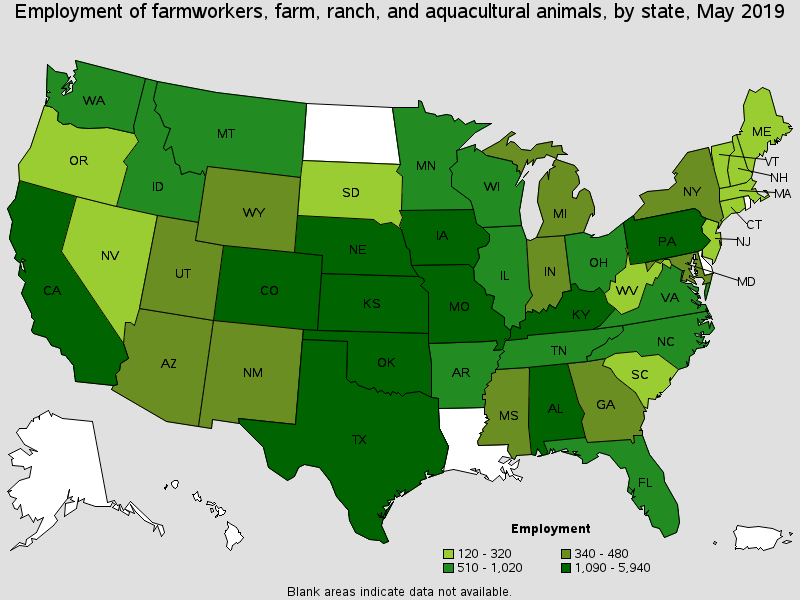
States with the highest employment level in this occupation:
| State | Employment (1) | Employment per thousand jobs | Location quotient (9) | Hourly mean wage | Annual mean wage (2) |
|---|---|---|---|---|---|
| Texas | 5,940 | 0.48 | 1.92 | $13.68 | $28,450 |
| California | 2,410 | 0.14 | 0.56 | $15.58 | $32,410 |
| Kentucky | 1,820 | 0.96 | 3.85 | $13.64 | $28,370 |
| Missouri | 1,490 | 0.53 | 2.12 | $14.09 | $29,300 |
| Pennsylvania | 1,450 | 0.25 | 0.99 | $13.39 | $27,860 |
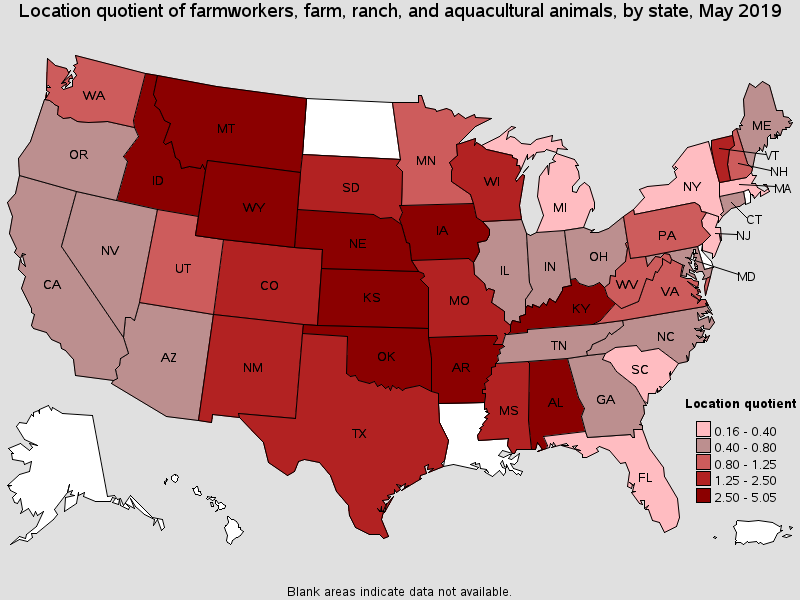
States with the highest concentration of jobs and location quotients in this occupation:
| State | Employment (1) | Employment per thousand jobs | Location quotient (9) | Hourly mean wage | Annual mean wage (2) |
|---|---|---|---|---|---|
| Wyoming | 340 | 1.26 | 5.05 | $13.32 | $27,700 |
| Idaho | 870 | 1.20 | 4.81 | $14.60 | $30,360 |
| Nebraska | 1,090 | 1.11 | 4.46 | $15.66 | $32,560 |
| Montana | 510 | 1.10 | 4.41 | $14.19 | $29,510 |
| Kentucky | 1,820 | 0.96 | 3.85 | $13.64 | $28,370 |
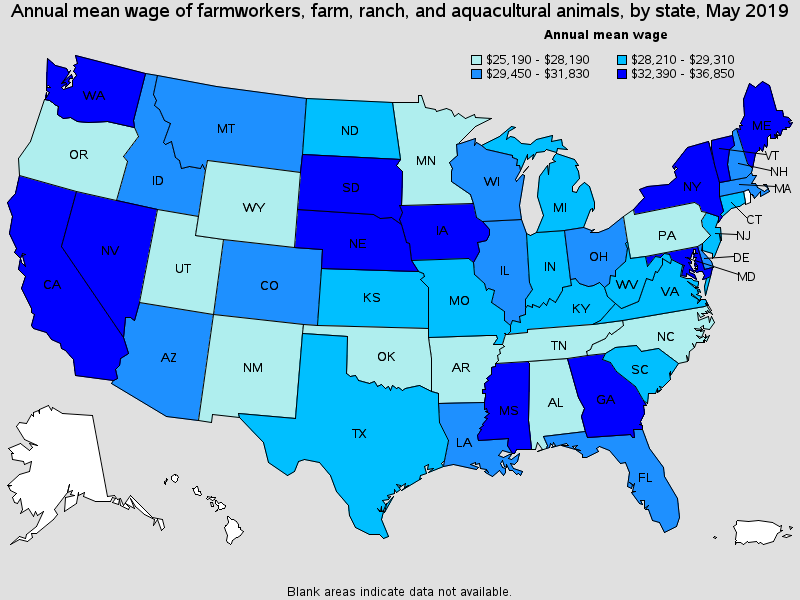
Top paying States for this occupation:
| State | Employment (1) | Employment per thousand jobs | Location quotient (9) | Hourly mean wage | Annual mean wage (2) |
|---|---|---|---|---|---|
| Nevada | 150 | 0.11 | 0.44 | $17.72 | $36,850 |
| New York | 370 | 0.04 | 0.16 | $17.66 | $36,730 |
| Mississippi | 470 | 0.41 | 1.65 | $17.50 | $36,390 |
| Vermont | 150 | 0.49 | 1.98 | $16.68 | $34,690 |
| Washington | 1,010 | 0.30 | 1.22 | $16.64 | $34,610 |
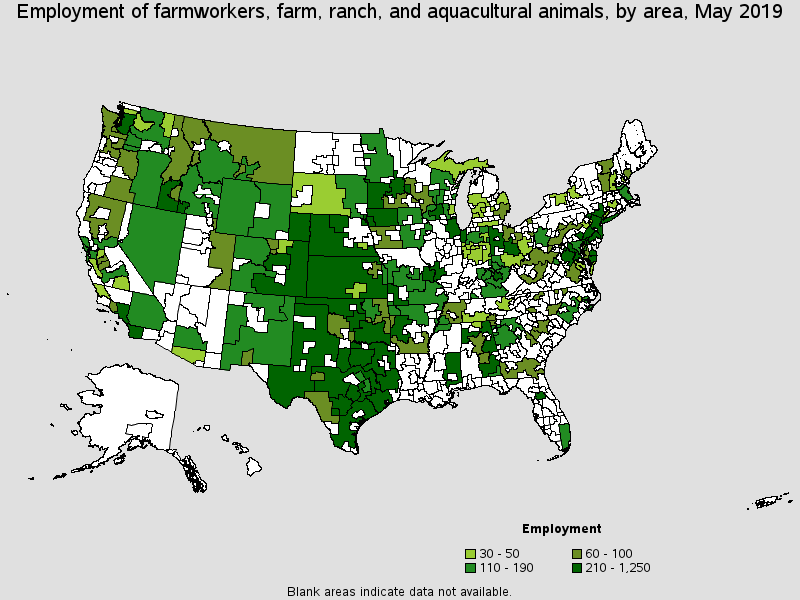
Metropolitan areas with the highest employment level in this occupation:
| Metropolitan area | Employment (1) | Employment per thousand jobs | Location quotient (9) | Hourly mean wage | Annual mean wage (2) |
|---|---|---|---|---|---|
| Lexington-Fayette, KY | 1,250 | 4.59 | 18.39 | $13.73 | $28,560 |
| Dallas-Fort Worth-Arlington, TX | 1,060 | 0.29 | 1.16 | $13.29 | $27,640 |
| Philadelphia-Camden-Wilmington, PA-NJ-DE-MD | 540 | 0.19 | 0.75 | $13.56 | $28,210 |
| Houston-The Woodlands-Sugar Land, TX | 540 | 0.18 | 0.71 | $16.31 | $33,930 |
| Austin-Round Rock, TX | 500 | 0.47 | 1.87 | $18.24 | $37,940 |
| Los Angeles-Long Beach-Anaheim, CA | 410 | 0.07 | 0.26 | $14.49 | $30,140 |
| Lancaster, PA | 390 | 1.55 | 6.21 | $14.21 | $29,550 |
| St. Louis, MO-IL | 380 | 0.28 | 1.11 | $14.56 | $30,290 |
| Seattle-Tacoma-Bellevue, WA | 370 | 0.18 | 0.74 | $15.79 | $32,850 |
| Chicago-Naperville-Elgin, IL-IN-WI | 360 | 0.08 | 0.30 | $14.67 | $30,510 |
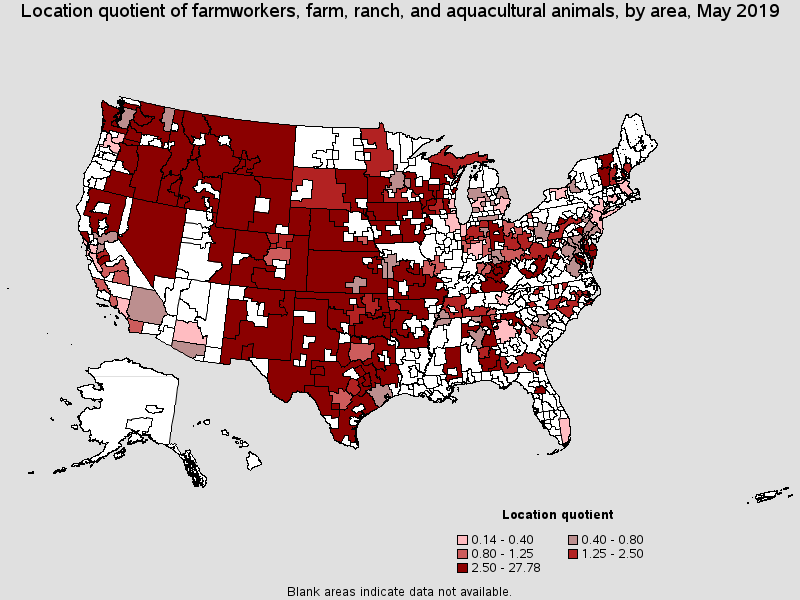
Metropolitan areas with the highest concentration of jobs and location quotients in this occupation:
| Metropolitan area | Employment (1) | Employment per thousand jobs | Location quotient (9) | Hourly mean wage | Annual mean wage (2) |
|---|---|---|---|---|---|
| Twin Falls, ID | 320 | 6.93 | 27.78 | $11.78 | $24,490 |
| Lexington-Fayette, KY | 1,250 | 4.59 | 18.39 | $13.73 | $28,560 |
| Sioux City, IA-NE-SD | 260 | 3.04 | 12.19 | $15.29 | $31,800 |
| Harrisonburg, VA | 140 | 2.11 | 8.48 | $13.75 | $28,600 |
| San Angelo, TX | 100 | 2.05 | 8.24 | $12.15 | $25,270 |
| Dothan, AL | 120 | 2.02 | 8.09 | $13.71 | $28,530 |
| Ocala, FL | 210 | 1.98 | 7.95 | $13.82 | $28,740 |
| Billings, MT | 160 | 1.81 | 7.25 | $15.15 | $31,520 |
| Lancaster, PA | 390 | 1.55 | 6.21 | $14.21 | $29,550 |
| Jefferson City, MO | 110 | 1.52 | 6.08 | $12.57 | $26,150 |
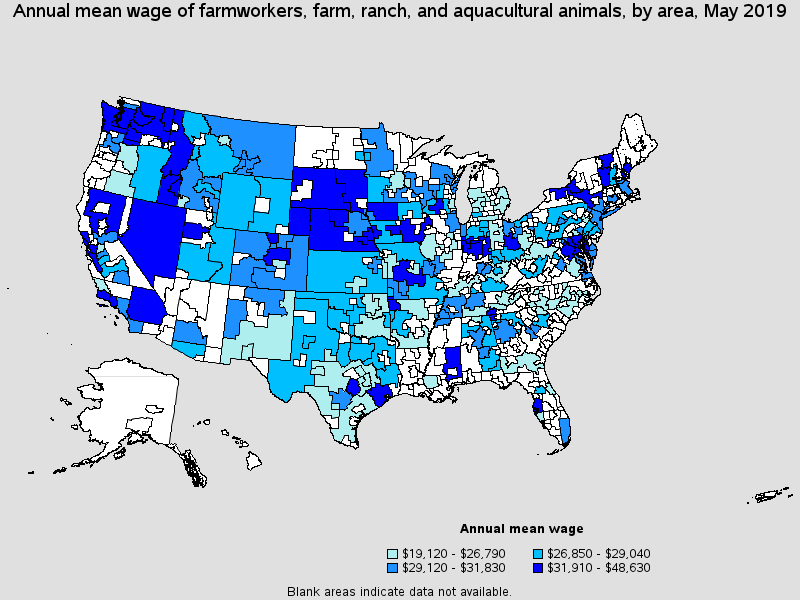
Top paying metropolitan areas for this occupation:
| Metropolitan area | Employment (1) | Employment per thousand jobs | Location quotient (9) | Hourly mean wage | Annual mean wage (2) |
|---|---|---|---|---|---|
| Wenatchee, WA | 30 | 0.65 | 2.61 | $23.38 | $48,630 |
| Riverside-San Bernardino-Ontario, CA | 180 | 0.12 | 0.47 | $20.55 | $42,740 |
| Tampa-St. Petersburg-Clearwater, FL | (8) | (8) | (8) | $20.12 | $41,850 |
| San Jose-Sunnyvale-Santa Clara, CA | 40 | 0.04 | 0.15 | $20.12 | $41,850 |
| Washington-Arlington-Alexandria, DC-VA-MD-WV | 340 | 0.11 | 0.43 | $19.17 | $39,870 |
| Austin-Round Rock, TX | 500 | 0.47 | 1.87 | $18.24 | $37,940 |
| Des Moines-West Des Moines, IA | (8) | (8) | (8) | $18.10 | $37,640 |
| Yakima, WA | 110 | 1.21 | 4.84 | $17.80 | $37,010 |
| Boise City, ID | 210 | 0.63 | 2.51 | $17.76 | $36,940 |
| Lincoln, NE | 40 | 0.23 | 0.91 | $17.34 | $36,070 |
Nonmetropolitan areas with the highest employment in this occupation:
| Nonmetropolitan area | Employment (1) | Employment per thousand jobs | Location quotient (9) | Hourly mean wage | Annual mean wage (2) |
|---|---|---|---|---|---|
| Kansas nonmetropolitan area | 970 | 2.45 | 9.83 | $13.60 | $28,290 |
| Hill Country Region of Texas nonmetropolitan area | 730 | 3.72 | 14.93 | $11.85 | $24,660 |
| Northwest Iowa nonmetropolitan area | 540 | 3.98 | 15.98 | $16.58 | $34,490 |
| Coastal Plains Region of Texas nonmetropolitan area | 460 | 3.02 | 12.12 | $11.64 | $24,210 |
| West Arkansas nonmetropolitan area | 390 | 4.46 | 17.89 | $13.14 | $27,330 |
Nonmetropolitan areas with the highest concentration of jobs and location quotients in this occupation:
| Nonmetropolitan area | Employment (1) | Employment per thousand jobs | Location quotient (9) | Hourly mean wage | Annual mean wage (2) |
|---|---|---|---|---|---|
| Northwest Nebraska nonmetropolitan area | 220 | 5.57 | 22.32 | $15.63 | $32,500 |
| West Arkansas nonmetropolitan area | 390 | 4.46 | 17.89 | $13.14 | $27,330 |
| Southwest Missouri nonmetropolitan area | 330 | 4.37 | 17.54 | $14.59 | $30,350 |
| Northwest Alabama nonmetropolitan area | 280 | 4.34 | 17.39 | $13.35 | $27,770 |
| Northwest Iowa nonmetropolitan area | 540 | 3.98 | 15.98 | $16.58 | $34,490 |
Top paying nonmetropolitan areas for this occupation:
| Nonmetropolitan area | Employment (1) | Employment per thousand jobs | Location quotient (9) | Hourly mean wage | Annual mean wage (2) |
|---|---|---|---|---|---|
| Western Washington nonmetropolitan area | 90 | 0.72 | 2.87 | $20.04 | $41,690 |
| Central East New York nonmetropolitan area | (8) | (8) | (8) | $18.25 | $37,960 |
| Nevada nonmetropolitan area | 130 | 1.32 | 5.28 | $17.67 | $36,740 |
| Northwestern Idaho nonmetropolitan area | 60 | 0.86 | 3.43 | $17.21 | $35,790 |
| Southern Vermont nonmetropolitan area | 70 | 0.68 | 2.74 | $17.06 | $35,490 |
These estimates are calculated with data collected from employers in all industry sectors, all metropolitan and nonmetropolitan areas, and all states and the District of Columbia. The top employment and wage figures are provided above. The complete list is available in the downloadable XLS files.
The percentile wage estimate is the value of a wage below which a certain percent of workers fall. The median wage is the 50th percentile wage estimate--50 percent of workers earn less than the median and 50 percent of workers earn more than the median. More about percentile wages.
(1) Estimates for detailed occupations do not sum to the totals because the totals include occupations not shown separately. Estimates do not include self-employed workers.
(2) Annual wages have been calculated by multiplying the hourly mean wage by a "year-round, full-time" hours figure of 2,080 hours; for those occupations where there is not an hourly wage published, the annual wage has been directly calculated from the reported survey data.
(3) The relative standard error (RSE) is a measure of the reliability of a survey statistic. The smaller the relative standard error, the more precise the estimate.
(8) Estimate not released.
(9) The location quotient is the ratio of the area concentration of occupational employment to the national average concentration. A location quotient greater than one indicates the occupation has a higher share of employment than average, and a location quotient less than one indicates the occupation is less prevalent in the area than average.
Other OES estimates and related information:
May 2019 National Occupational Employment and Wage Estimates
May 2019 State Occupational Employment and Wage Estimates
May 2019 Metropolitan and Nonmetropolitan Area Occupational Employment and Wage Estimates
May 2019 National Industry-Specific Occupational Employment and Wage Estimates
Last Modified Date: July 6, 2020